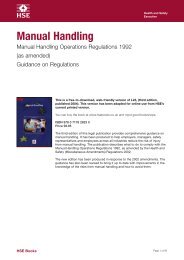Making Companies Safe - what works? (CCA ... - Unite the Union
Making Companies Safe - what works? (CCA ... - Unite the Union
Making Companies Safe - what works? (CCA ... - Unite the Union
Create successful ePaper yourself
Turn your PDF publications into a flip-book with our unique Google optimized e-Paper software.
Second, even if low injury rates genuinely reflect effective safety management, <strong>the</strong>y cannot<br />
(as we have seen) guarantee that individual employers are effectively managing health<br />
hazards. For example, whilst DuPont is acknowledged to have extremely low lost-time injury<br />
and illness rates relative to <strong>the</strong> rest of US industry, Ruttenberg and Huggins (1981) cite<br />
evidence – including OHSA citations for wilful violations relating to excessive asbestos<br />
exposure and NIOSH reports of excess cancers at particular DuPont plants – to suggest that<br />
DuPont has neglected occupational health issues. 122<br />
Nor can low injury rates provide assurance that individual enterprises are effectively<br />
managing <strong>the</strong> risks of a major incident. For example, <strong>the</strong> Esso gas plant explosion and <strong>the</strong> case<br />
of BP’s Grangemouth complex – both discussed in <strong>the</strong> previous chapter – illustrate <strong>the</strong><br />
dangers of using injury or sickness rates to judge general OHS performance. A study of <strong>the</strong><br />
Esso plant reveals that one of <strong>the</strong> causes of <strong>the</strong> explosion was <strong>the</strong> fact that management was<br />
more concerned with reducing <strong>the</strong> economic costs of lost-time injuries than <strong>the</strong> consequences<br />
of a major incident. 123<br />
Similarly, <strong>the</strong> Westray mine in Canada had won a prestigious national safety award based<br />
on low recorded injuries just a few months before it exploded in 1992. 124 And whilst BP<br />
Grangemouth won a European-wide award for its management of psychosocial risks, it had<br />
in <strong>the</strong> previous year been prosecuted by <strong>the</strong> HSE and fined £1 million following three<br />
life-threatening incidents occurring at <strong>the</strong> complex within <strong>the</strong> space of a month. A report by<br />
<strong>the</strong> HSE found that managers had failed to detect “deteriorating performance” and failed to<br />
abide by <strong>the</strong> law. 125 These examples suggest that management initiatives on health and safety<br />
will not necessarily correspond to areas of greatest risk, but may be directed towards hazards<br />
that are perceived as involving an immediate financial cost to <strong>the</strong> company, or towards<br />
hazards that are perhaps seen as easy or cheap to address.<br />
Resources<br />
The primary impetus behind <strong>the</strong> HSE’s consideration of earned autonomy appears to be<br />
budgetary. However, <strong>the</strong>re are good reasons to believe that earned autonomy will not<br />
deliver <strong>the</strong> ‘savings’ needed to enable HSE to significantly increase its contact with ‘poor<br />
performers’. Indeed <strong>the</strong>re is evidence that <strong>the</strong> scheme may actually consume more resources<br />
than routine inspections do. While budgetary arguments were a main motive behind OSHA’s<br />
introduction of VPP, <strong>the</strong> Californian CPP actually consumed enormous resources, involving ten<br />
times more OSHA staff than traditional inspections. 126 Similar resource problems arose in<br />
relation to Maine 200, which according to Needleman:<br />
“badly strained <strong>the</strong> resources of Maine’s Area Office, cutting in to <strong>the</strong> agency’s<br />
o<strong>the</strong>r work and overloading <strong>the</strong> staff in ways that made <strong>the</strong>m wish it have been<br />
called ‘Maine 100’. 127<br />
This was <strong>the</strong> case even though OSHA had withdrawn from routine inspection of participating<br />
firms. Moreover, in view of <strong>the</strong> fact that changing circumstance can have an adverse effect<br />
on health and safety performance, some sort of continuing regulatory oversight would be<br />
crucial. Recognising that oversight and vetting of SMSs are likely to impose considerable<br />
burdens on regulatory agencies, Gunningham and Johnstone suggest that this auditing<br />
function could be performed by a suitably qualified third-party, with <strong>the</strong> audit paid for by <strong>the</strong><br />
organisation. 128 This suggestion is consistent with <strong>the</strong> proposal put forward by <strong>the</strong> HSE in<br />
<strong>the</strong>ir discussion document. 129 Potential problems with this proposal will be discussed below.<br />
96<br />
Assuming for <strong>the</strong> moment that problems with selecting firms for earned autonomy status are<br />
overcome, and assuming that auditing is an appropriate form of oversight and that this could<br />
be carried out in a way that consumed less regulatory resources than traditional inspections,<br />
precisely how much money was saved would depend on <strong>the</strong> number of companies selected<br />
for earned autonomy status. Evidence is lacking about <strong>the</strong> extent to which individual<br />
employers within <strong>the</strong> UK have adopted <strong>the</strong> kind of fully-fledged SMSs that might be required<br />
by <strong>the</strong> HSE as a basis for achieving earned autonomy status. 130 However, <strong>the</strong> evidence that<br />
does exist suggests that such firms are few and far between. 131 The most likely contenders<br />
would be organisations in <strong>the</strong> high-risk sectors, but <strong>the</strong> nature of <strong>the</strong> activities carried out by<br />
<strong>the</strong>se firms means that <strong>the</strong> consequences of failure may be deemed too great.
















